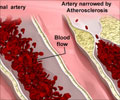Shedding light on the unhealthy lifestyle of Indian women, a new study has found that three in five women in the country are at high risk of cardiovascular diseases.

According to the study, the largest group of women at risk of CVD is aged between 35 and 44 and the risk is as high amongst housewives as it is amongst working professionals.
Around 69 percent of Indian housewives and 67 percent of Indian working professionals over the age of 35 are at the risk of CVD.
Findings of the study state that women are more at risk of heart disease today than 3 three years ago. It was also found that low HDL (high density lipoprotein) and high BMI (body mass index) are the two most common contributors to CVD risk setting in as early as 35 years for women.
Pravin Chandra, Chairman and Cardiologist at Medanta – The Medicity, said that, “Smoking, diabetes and high BP are the other reasons putting women at risk of cardiovascular diseases. Sedentary lifestyle, stressful work conditions and compromised diet also contribute in accelerating heart disease risk.”
Key risk factors for CVD risk setting in as early as 35 years:
• ‘Not enough good cholesterol’ was found to be the number one risk factor for heart disease. Eight in 10 women above the age of 35 who are at CVD risk have low HDL. High level of HDL cholesterol reduces the risk of the heart diseases.
• Among women at risk, housewives more likely to be overweight than working women and more prone to diabetes. Working women are less physically active than housewives.
The study states, lifestyle factors have also contributed to the increase in heart disease risk. It was found that poor lifestyle choices at an early age (35-44) are common among women at CVD risk.
Ms. Niti Desai, nutritionist and consultant dietician nutritionist said, “Major causes of obesity include high saturated fat, sugar and salt intake, very low consumption of vegetables and whole grains. Sedentary lifestyles, rising stress levels and smoking are the other key contributory factors for deterioration of heart health in women.”
Findings on lifestyle factors for CVD risk setting in as early as 35 years:
• Women not making their nutritional needs a priority are at the risk of heart disease. It is discovered that 73% women at CVD risk consume 2 or less servings of whole grains per day.
• Lack of physical activity is putting you at risk of heart disease more than you think. Almost 70% women are thrice less physically active in a week.
• 56% working women eat less than 1 serving of vegetables per day as compared to 46% housewives in the same age group.
The study suggests that cholesterol test is important to assess the heart condition. The study disclosed that out of the women who are at risk, only 15.4% have ever been to a cholesterol (lipid test) check–up. The number is even lower for younger women aged 35-44 at 7.8%.
“It is evident that women ignore their own health and are not aware of the extent of risk of cardiovascular disease and are thus unable to take steps for a better heart health,” researchers concluded.
The study was conducted by Saffolalife, a not-for-profit initiative started of Marico. Marico is an Indian consumer goods company providing consumer products and services in the area of health.
Source-Medindia










